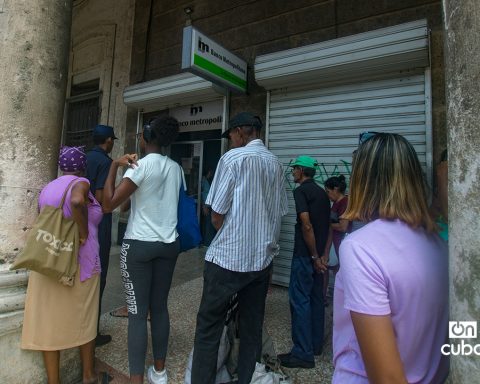A team of researchers from the National University of Buenos Aires (UBA) and the Argentine Antarctic Institute (IAA) spent the summer at the Deception base, built in 1948 on an island that is actually an active volcano with several eruptions recorded in the last 50 years and where they work to identify signs that allow us to understand their behavior.
Deception Island is part of a volcanic chain that rises from the Antarctic seabed, and includes a dozen volcanoes, three of which emerged as islands (Decepción, Bridgeman and Pingüino) and the rest remain submerged. In addition, the Decepción volcano is the only one with a historical record of eruptions.
The doctor in Geological Sciences, professor at the UBA and researcher at the Conicet, Mariano Augustoaffirmed -in dialogue with Télam- that “although it is true that the most recognizable characteristic of Antarctica is the great blanket of snow and ice and the fauna associated with that environment, it is also there are active volcanoes, and in the Argentine Antarctic sector the volcano on Deception Island has recorded and well-documented eruptions in 1967, 1969 and 1970″.
Agusto maintained that “between the northwest sector of the Antarctic Peninsula and the South Shetland archipelago there is a strait known as the Fleet Sea (or Bransfield Strait) where the volcanic chain from which Deception Island emerges develops. “This had been discovered by English and Norwegian seal-whaling expeditionaries during the 19th century. The activity was abandoned on the island at the beginning of the 20th century, due to the fall in the price of whale oil when oil replaced it as fuel.”

“Argentina established the Decepción Antarctic base there in 1948 and Chile and the United Kingdom also built their own facilities. The eruptions of 1967 and 1969 destroyed the facilities of both countries and left the island”he remembered.
The researcher recounted that “until the 1967 eruption, the Argentina Decepción base was permanent, but since those last eruptions, Argentina used its location as a summer base dedicated to volcanology studies, while at the beginning of the last decade of the 20th century Spain installed a base that performs seismological monitoring among other studies. This summer, with the deployment of the team of five researchers who work in that place, Argentina reactivated its volcanological investigations in the region, after nearly ten years.”
The research team was made up of Agusto, Clara Lamberti, Pablo Forte, Lucas Guerriero, and Adriana Ariza Pardo (guest researcher from Colombia). The work was carried out within the framework of a joint project with the IAA, and with the logistical support of the forces of the Joint Antarctic Command.
“The Argentine investigations on the Island, although they cover aspects of volcanology in general, They focus on the geochemical study of volcanic gases, their particular fumarolic emissions and that of their thermal waters. that, in addition, are a great attraction for Antarctic tourism and almost an obligatory stop for the cruise ships that operate in the area”, he mentioned.

Agusto clarified that “the entire island is an active volcano, fed by an active magmatic chamber that can erupt within 50 years or within a month. So far it is complex to estimate when it could have a new eruption and if it would be with greater or less violence, but what we can do is investigate it to determine its characteristics and identify signs that allow us to understand its behavior.

“From the study of the rocks, the geological record of the island, we know that some eruptions were calmer and others more violent and that this is linked to where on the island they developed because when the magma comes into contact with the water, the eruptions become more energetic. On the other hand, from the study of the current signals that we are now carrying out, such as the variations in composition, flow and temperature of the volcanic gases, the objective is to establish a baseline with information that allows us to build a pattern of behavior of the volcano. , fundamental for the identification of precursor signals of a future reactivation”, he indicated.
The scientist stressed that “the researchers who were in Decepción this summer are part of the Group for the Study and Monitoring of Active Volcanoes (Gesva), from the Idean institute of the UBA and the Conicet, which every summer we work on active volcanoes in the Cordillera de the Andes such as the Copahue in Neuquén or the Peteroa in Mendoza, together with other Argentine organizations such as the Argentine Volcanic Surveillance Observatory (Segemar) and the CNEA Those of us who work in this discipline know that it is an activity that implies risks, but We take the necessary precautions. On Deception Island we also have the support of seismological information from the Spanish base (and for the next few years we also hope from Segemar) to find out if something out of the ordinary happens and, in the event that If the data indicates an upcoming risk, we know that by issuing an alert in one or two days we can be evacuated”.
“Another important aspect is that volcanological monitoring of Deception Island Studies have been added that provide more information on the geothermal characteristics of the island, which will give us greater detail on the characteristics of this particular volcanic-hydrothermal system,” Agusto added.
The Decepción Base is located on the southwest coast of Primero de Mayo Bay on Decepción Island in the South Shetlands, about 1,000 kilometers from the Fuegian city of Ushuaia and about 3,100 kilometers in a straight line from Buenos Aires, its average minimum temperature temperature is 5.5 degrees below zero and an average annual maximum temperature of 1.2 degrees below zero.



















